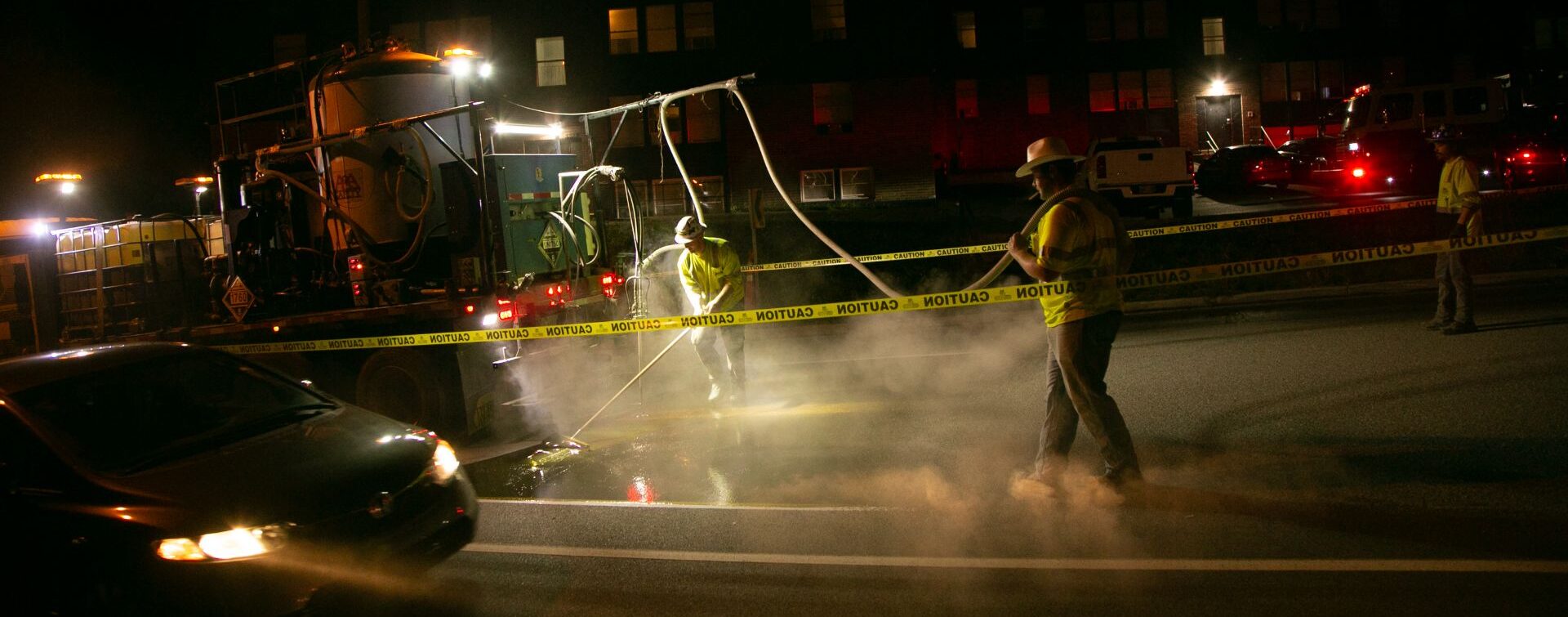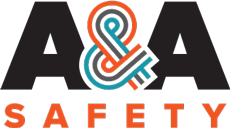What You Need to Know When Starting a New High Friction Surface Treatment Road Project
Adding a High-Friction Surface Treatment (HFST) Can Reduce Wet Crashes by 83%
An efficient and impressive surface system is emerging in the fight to make roads safer: High-Friction Surface Treatment. It’s a simple concept that can have a big impact, with numerous examples citing overall crash reduction in the 55%-75% range. Evidence suggests that wet crashes, in particular, can be reduced by as much as 83% or more.
With a relatively cost-effective price point and quick application timelines, states and municipalities are increasingly turning to this highly effective technique to increase road safety and save lives.
How Do High Friction Surface Treatments work?
High-Friction Surface Treatments apply a high-quality aggregate material to the surface of roads to prevent skids and crashes. Drivers are generally unaware that the surface has been treated to increase safety.
Epoxy is used as a thin polymer binding that is applied to the road surface and then layered with a topping of high-friction aggregate such as Calcined Bauxite.
Although the technology and material needed for High Friction Surface Treatment (HFST) have existed for decades, the benefits to drivers and overall road safety have only recently become more apparent as states and municipal authorities have begun to see results of trials implemented in recent years.
Where and How Are High Friction Surfaces Used for Road Safety?
High-Friction Surface Treatments offer a unique and targeted solution for improving road safety in limited areas where skids and short stops often occur. It is an excellent enhancement to use where other safety methods cannot be applied or are not working. In fact, research shows that HFSTs are often more effective than alternatives, such as signage, rumble strips and chevron markings.
Top Road Surfaces Where High-Friction Treatments Are Most Valuable:
- Sharp Curves, Especially Those Without Banking – Over time, curved roads become “polished” as friction occurs. This has the impact of making roads even more slippery and skid-prone. This scenario is very common on “horizontal” two-lane roads that do not have banking to help you maintain your speed like highways often do.
- Busy Intersections and Merge Lanes – Places where vehicles are frequently entering or leaving the road are highly prone to crashes. Applying HFSTs can help drivers swiftly adjust and stop more quickly to avoid collisions.
- Roads Near Steep Grades – These types of roads carry two uses of HFSTs. If located where it would be dangerous for a driver to veer off the road, a High-Friction Surface can be applied to the road itself. Additionally, the treatments can be applied to steep banks near bridges and elevated roads to help maintain the integrity of the bank.
Why You Should Be Considering High-Friction Surface Treatments
For states and municipalities considering adding HFSTs as a part of their road improvement initiatives, there are some strong reasons to do so:
Improving Safety and Saving Lives – Study after study indicates that High-Friction Surfaces are highly effective, especially in wet conditions. Tapping into the capability saves lives and reduces property damage.
Reduced Liability – Reducing accident rates can mean fewer liability claims and lawsuits from affected drivers.
Cost Effective / Strong ROI – High-friction surfaces are relatively low-cost in comparison to some alternatives and have been found to produce a strong ROI. Some case studies estimate a cost-benefit ratio of 24-to-1.
Compliance & Funding – Many state DOTs offer incentives and funding to local cities, counties or any public road owner to improve systemic road safety, including a focus on intersections and road surfaces.

State Funding Opportunities for Road Safety Projects
Many states have advisory boards and agencies, often including funding and grants, to support goals associated with reducing roadway crashes and saving lives. To investigate possible funding sources for HFS initiatives, check out these resources:
Important Factors to Consider When Installing a High-Friction Surface Treatment
As you start to embark on a new HFST project, here are some of the top aspects of the project to consider:
- Site Assessment: You will need to determine where the HFS is most beneficial. Typically the treatment is applied where most people start braking and continues through the curve or intersection.
- Surface Preparation: The site and existing surface must cleaned and prepared to ensure proper adhesion.
- Installation: Specialized trucks, binder spreaders, and other equipment may be necessary. Additionally, the type of aggregate and binding material you need may depend on the location and safety needs of that portion of the road.
A&A Safety Advantage: We have custom-built trucks specifically designed for HFST surface prep and application.
- Curing Time: Many things impact curing time, including weather and the condition of the existing surface.
- Cost: The number of sites you plan to use high-friction treatments on and the total square yardage of those locations will factor into total costs.
- Pavement Marking Removal and Restriping: Depending on the location that will be receiving the HFST, pavement marking may need to be removed before application and then reinstalled after the high friction surface has been added.
- Traffic Disruption: Managing traffic during installation is a key element of the project planning.
Pro tip: A&A Safety offers MOT services as well as pavement marking removal and installation to provide a turnkey, full-service solution for any pavement or road maintenance services.
- Weather Conditions: As with any road improvement project, the weather may impact several factors associated with completing a high-friction surface project.
- Lifecycle and Maintenance: Adding an HFST is a durable solution designed specifically to handle wear and tear over the long haul. The quality of the original road surface, along with the type of material used and application methods, can impact the long-term durability of the new surface. Additionally, the HFS area may need to be cleaned several times shortly after it is applied to ensure any loose aggregate is removed. On a long-term basis, some maintenance may be required as normal road design, improvements and construction impact the area.
Rely on A&A Safety, Your Trusted High-Friction Surface Treatment Contractor
Looking for road safety professionals you can trust? As the Pavement Marking experts throughout Ohio, Kentucky, Indiana and other surrounding areas, A&A offers the subject matter expertise you need to plan, staff and execute on all your road improvement projects. In addition to being one of the best high-friction surface treatment companies, we offer turnkey maintenance of traffic (MOT) services, so all your projects are coordinated expertly with minimal disruption of traffic. Plus, we design and build our own fleet of specialized trucks, so we always offer best-in-class equipment for the job at hand.
The Evidence is Clear: HFSTs Work
Are you ready to bring high-friction surfaces to your local roadways? Let A&A help. Together, we can make the roads safer and save lives. Contact us today for more information.
Additional Resources:
- https://highways.dot.gov/safety/rwd/keep-vehicles-road/pavement-friction/hfst
- https://highways.dot.gov/safety/rwd/keep-vehicles-road/pavement-friction/case-studies-and-noteworthy-practices
- https://highways.dot.gov/safety/rwd/keep-vehicles-road/pavement-friction/faqs-links-and-other-resources#hfst
- https://www.atssa.com/resource/hfst-installation-lessons-learned/
- https://www.pa.gov/agencies/penndot/about-penndot/advisory-committees-boards-and-commissions/state-transportation-innovation-council/innovations/high-friction-surface-treatment.html
- https://www.fhwa.dot.gov/innovation/everydaycounts/edc-2/pdfs/fhwa-cai-14-019_faqs_hfst_mar2014_508.pdf
- https://www.odot.org/materials/tech-reports/BDR74-977-05.pdf
- https://dot.ca.gov/-/media/dot-media/programs/local-assistance/documents/hsip/2017/iv2b-rdcountermeasuresworkshophandford.pdf
- https://www.transportation.ohio.gov/programs/highway+safety/highway-safety-improvement-program
